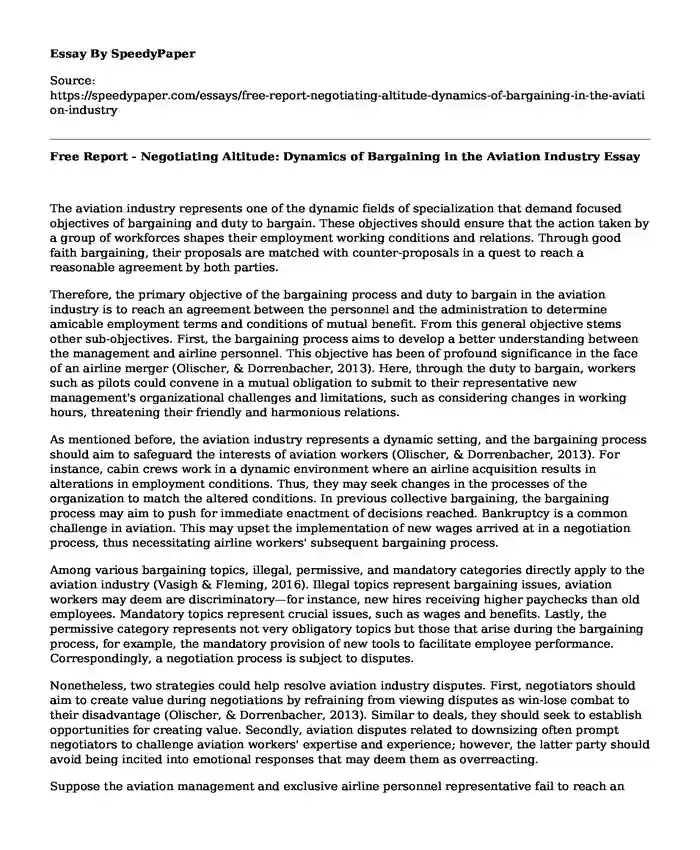
| Type of paper: | Essay |
| Categories: | Aviation |
| Pages: | 3 |
| Wordcount: | 708 words |
The aviation industry represents one of the dynamic fields of specialization that demand focused objectives of bargaining and duty to bargain. These objectives should ensure that the action taken by a group of workforces shapes their employment working conditions and relations. Through good faith bargaining, their proposals are matched with counter-proposals in a quest to reach a reasonable agreement by both parties.
Therefore, the primary objective of the bargaining process and duty to bargain in the aviation industry is to reach an agreement between the personnel and the administration to determine amicable employment terms and conditions of mutual benefit. From this general objective stems other sub-objectives. First, the bargaining process aims to develop a better understanding between the management and airline personnel. This objective has been of profound significance in the face of an airline merger (Olischer, & Dorrenbacher, 2013). Here, through the duty to bargain, workers such as pilots could convene in a mutual obligation to submit to their representative new management's organizational challenges and limitations, such as considering changes in working hours, threatening their friendly and harmonious relations.
As mentioned before, the aviation industry represents a dynamic setting, and the bargaining process should aim to safeguard the interests of aviation workers (Olischer, & Dorrenbacher, 2013). For instance, cabin crews work in a dynamic environment where an airline acquisition results in alterations in employment conditions. Thus, they may seek changes in the processes of the organization to match the altered conditions. In previous collective bargaining, the bargaining process may aim to push for immediate enactment of decisions reached. Bankruptcy is a common challenge in aviation. This may upset the implementation of new wages arrived at in a negotiation process, thus necessitating airline workers' subsequent bargaining process.
Among various bargaining topics, illegal, permissive, and mandatory categories directly apply to the aviation industry (Vasigh & Fleming, 2016). Illegal topics represent bargaining issues, aviation workers may deem are discriminatory—for instance, new hires receiving higher paychecks than old employees. Mandatory topics represent crucial issues, such as wages and benefits. Lastly, the permissive category represents not very obligatory topics but those that arise during the bargaining process, for example, the mandatory provision of new tools to facilitate employee performance. Correspondingly, a negotiation process is subject to disputes.
Nonetheless, two strategies could help resolve aviation industry disputes. First, negotiators should aim to create value during negotiations by refraining from viewing disputes as win-lose combat to their disadvantage (Olischer, & Dorrenbacher, 2013). Similar to deals, they should seek to establish opportunities for creating value. Secondly, aviation disputes related to downsizing often prompt negotiators to challenge aviation workers' expertise and experience; however, the latter party should avoid being incited into emotional responses that may deem them as overreacting.
Suppose the aviation management and exclusive airline personnel representative fail to reach an agreement during the bargaining process; arbitration and mediation are two suitable methods of addressing impasses without resorting to strikes. In arbitration, the dispute should be referred to an impartial third party whose decision is final and binding (Van Asselt, 1972). Alternatively, in the mediation method, a neutral third party could intervene in the dispute to convince the two sides to reach an agreement.
Conclusion
In summation, the three objectives of the aviation industry's bargaining process and duty to bargain are developing a better understanding between the management and airline personnel, protecting employees' interests, and pushing for prompt implementation of previous collective bargaining decisions. In the case of realizing these objectives, bargaining issues are grouped into three topics: illegal, permissive, and mandatory. Aspects of downsizing and expertise are two possible causes of disputes during negotiation. However, two strategies could help attain a resolution: focusing on value-creating opportunities and evading overreactive responses from employees' sides. Similarly, when negotiations between two parties fail, arbitration and mediation are the two suitable methods of addressing impasses without a strike.
References
Olischer, F. T., & Dörrenbächer, C. (2013). Concession bargaining in the airline industry: Ryanair's policy of route relocation and withdrawal (No. 73). Working Papers of the Institute of Management Berlin at the Berlin School of Economics and Law (HWR Berlin).
Van Asselt, K. A. (1972). Impasse Resolution. Public Administration Review, 32(2), 114-119.
Vasigh, B., & Fleming, K. (2016). Introduction to air transport economics: from theory to applications. Routledge.
Cite this page
Free Report - Negotiating Altitude: Dynamics of Bargaining in the Aviation Industry. (2024, Jan 16). Retrieved from https://speedypaper.net/essays/free-report-negotiating-altitude-dynamics-of-bargaining-in-the-aviation-industry
Request Removal
If you are the original author of this essay and no longer wish to have it published on the SpeedyPaper website, please click below to request its removal:
- Study of Economic Essay Sample
- Essay Example Investigating the Hospitality Industry
- Free Essay with the Project Meeting Summary
- Marketing Essay Example: Advertising Tools in IMC Plans
- Presentation Example about Pneumonia, Free Paper for Everyone
- Sport Essay Example About Strength and Conditioning Coaches
- Paper Example: Lessons Learnt From the Challenger Disaster
Popular categories




